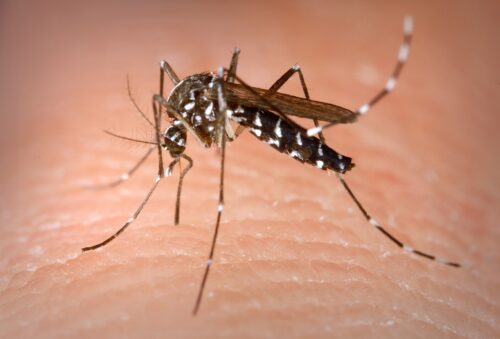The Asian tiger mosquito – tiger mosquito or forest mosquito – is a two-winged insect in the mosquito family and is considered a major public health risk.
Not to be confused with:
Culiseta annulata
Asian tiger mosquito (Aedes albopictus) – tiger mosquito or forest mosquito – is a two-winged insect in the family mosquitoes (Culicidae).
The species belongs in Asia, but the larvae of the tiger mosquito have spread almost worldwide as stowaways in shipments of all kinds of goods. The tiger mosquito is found both in the Americas and in large parts of Europe. The tiger mosquito can carry a wide range of diseases, including dengue (dengue fever), yellow fever, encephalitis ( brain inflammation ) and zika fever. The tiger mosquito can also transmit parasites, dangerous to humans and animals.
The tiger mosquito develops in stagnant, warm water, such as puddles of water in old car tires, birdbaths, flower pots, etc. Usually, tiger mosquitoes do not survive the winter. However, due to climate change and associated warming, the tiger mosquito will become more and more resilient. Tiger mosquitoes live on nectar from flowers; nectar from different plants is suitable. The insect is called a tiger mosquito for its striped appearance, which resembles that of the tiger. The tiger mosquito, like all mosquitoes, has many enemies. The larvae are eaten by a wide range of aquatic animals, including fish and aquatic insects and their larvae. The adult tiger mosquito is eaten by birds, frogs and dragonflies.
The tiger mosquito can survive in a broad range of climates and has spread rapidly from the point of first detection in the south-central United States. The tiger mosquito is considered a major public health risk and every effort is being made to control it or – in countries where the species has not yet established itself – to keep it out.
Where to find
- This mosquito has become a significant pest in many communities because it closely associates with humans (rather than living in wetlands), and typically flies and feeds in the daytime in addition to at dusk and dawn.
Control
To control several species of stinging flies and mosquitoes, including the Asian tiger mosquito, the bacterium Bacillus thuringiensis israelensis (BTI) has been developed. This biological control agent is used to kill tiger mosquito larvae living in the water.
Prevention
The main means of prevention is to prevent warming standing water. This emphatically involves small amounts of water, such as rainwater in car tires, children’s toys and flower pots.

